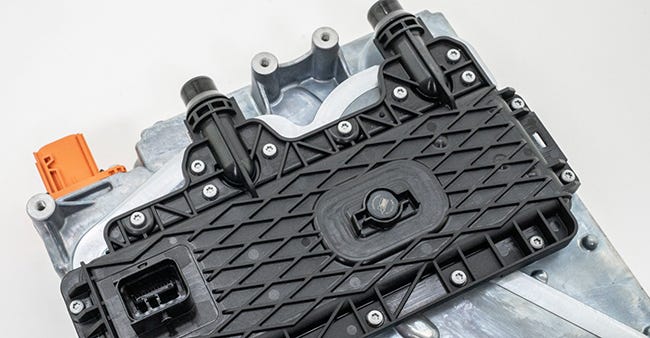Less range anxiety for consumers and reduced production costs are among the advantages.
July 2, 2022

As electric vehicle (EV) production ramps up and developing charging infrastructures make longer journeys more feasible, the onus is on automakers to further reduce vehicle mass. One of the remaining relatively untapped applications is the battery housing. Several alliances and individual companies are vying to develop commercial solutions.
Lanxess and Kautex Textron, for example, are experimenting with direct long-fiber thermoplastic (D-LFT) and polyamide 6 (PA 6) resins in a feasibility study. Aimplas, meanwhile, is developing sustainable structural battery casings for lightweight vehicles based on reusable, recyclable long-fiber thermoplastic composites. Discharged battery packs will be hot-swappable. In other developments, the Vestaro Consortium is adopting a novel approach based on lightweight sheet molding compounds for high-voltage battery module housings.
Shifting to PA 6
Inroads are also being made in peripheral EV battery components, with Lanxess again at the fore. According to the nylon supplier, PA 6 and PA 66 are materials with very similar properties, yet they are frequently in competition with one another. Recently, the tense pricing situation for PA 66 and its temporarily limited availability have resulted in it being replaced with PA 6 even in traditional applications. However, new developments in components that typically have been made from PA 66 are now increasingly being directly implemented in PA 6.
|
The black cover of the on-board battery charger is made of Durethan BKV50H3.0 from Lanxess, which is highly reinforced with 50% by weight of short glass fibers. |
One current example is the cover for an on-board battery charger used in an EV compact vehicle made by a German car manufacturer. It is composed of Durethan BKV50H3.0 from Lanxess, which is highly reinforced with 50% by weight of short glass fibers. The manufacturer of the system consisting of the cover and charger is Leopold Kostal GmbH & Co. KG (Luedenscheid, Germany), a global system supplier of automotive, industrial, and solar electrics as well as electrical connector systems.
This large-scale application underlines the fact that PA 6 compounds do not necessarily have to be hydrolysis-stabilized to be used in cooling applications with glycol-water coolants in electric vehicles. “We assume that in the future, polyamide 6 products of this type will become very common in the mass production of covers and other thermal management components for electric vehicles. That is especially the case for applications such as fluid connectors or control units in the cooling system,” explains Dr. Bernhard Helbich, Technical Key Account Manager at Lanxess’ High Performance Materials business unit.
Thermal management requirements differ in electric powertrains
Plastic components in the cooling circuit of combustion engines have long been the domain of PA 66. This is because the thermoplastic is highly resistant to hot coolants such as water-glycol mixtures. However, the requirements in the thermal management of purely electric powertrains are shifting toward lower temperatures. For all-electric vehicles, the long-term thermal resistance of polyamide 6 compounds to water-glycol mixtures is sufficient for most of the parts, even for the significantly longer stress times in some cases. Thus, the cover permanently withstands temperatures up to 85°C during vehicle operation without any problems and burst loads up to 10 bar are achieved. Long-term tests on samples also revealed that the mechanical properties of the compound in water-glycol mixtures hardly diminish. even after 1,500 hours of storage at 110°C and a pressure of 1.5 bar. As a result, the material meets the technical requirements of a major German carmaker for water-cooled components of electric vehicles.
At around 29 cm long and 12 cm wide, the cover has a considerable flange length. The cover, together with a seal, is screwed to the aluminum housing of the charger. The high strength and stiffness shown by the PA 6 compound ensures that the cover meets strict leak tightness requirements. Helbich comments, “To that end, we optimized the mechanical component properties in close collaboration with Kostal and, by simulating filling, we determined how minimum values for shrinkage and warpage can be achieved in injection molding processing.”
In addition, Durethan BKV50H3.0 employs copper-free H3.0 thermal stabilization that does not result in electrical corrosion occurring on metallic parts in the cooling circuit. It is resistant to media typically found in EV operation, such as oils, greases, battery electrolyte, and road salt.
About the Author(s)
You May Also Like





